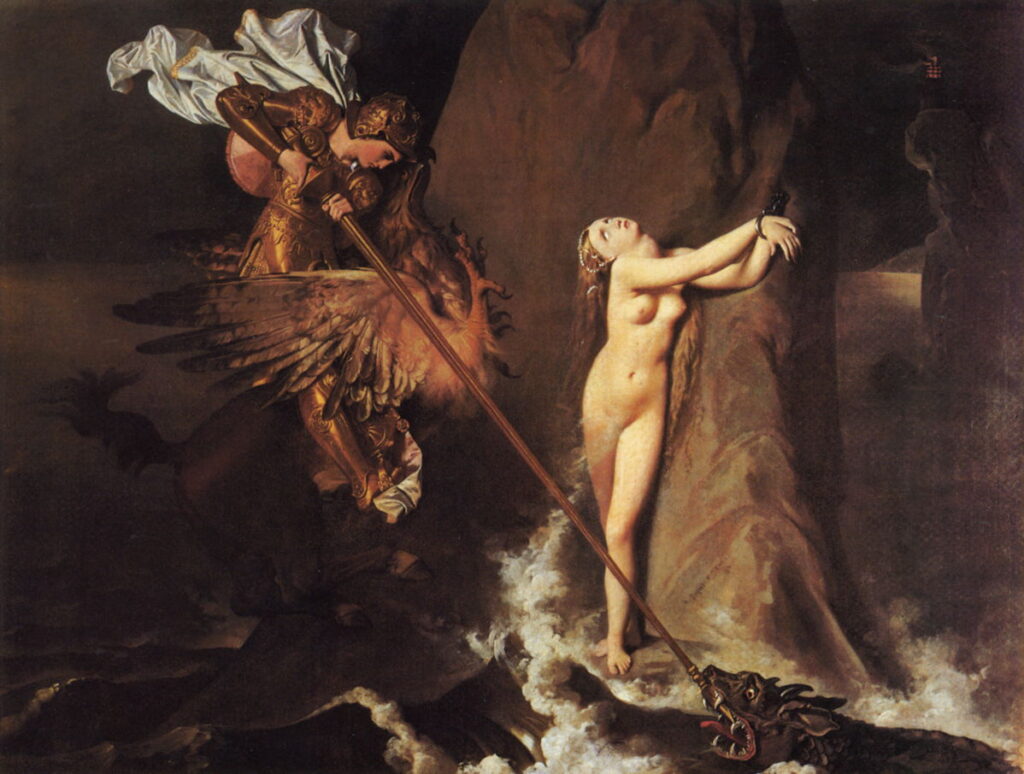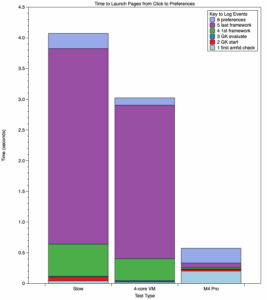Rescued from the sea-monster: Paintings of Angelica

In the first of these two articles, I looked at paintings of the story of Andromeda, who in classical myth was rescued from a sea-monster by the hero Perseus, who then married her as his prize. A near-identical plot appears in Ludovico Ariosto’s epic Orlando Furioso, published in abbreviated form in 1516, and in its final version after his death in 1532.
The people of the northern island of Ebuda have been cursed to feed their fairest maidens to an orc, and send their menfolk around the world to kidnap more to satisfy the sea monster’s appetite. The sleeping Angelica is their next victim, and is soon chained at the water’s edge awaiting her fate.
Ruggiero has been trying to escape from Alcina’s island where he had been trapped, and finally arrives at her sister Logistilla’s castle, where he has a special bit made for his hippogriff, enabling him to control its flight. He then flies west, crossing eastern Asia until he reaches London, where he sees reinforcements gathering to go to aid Charlemagne in Paris. He flies off to the north, and comes across Angelica chained and awaiting the arrival of the orc.
Ruggiero lands by her, and immediately thinks of his beloved Bradamante. Angelica feels her nakedness, and blushes with shame from head to toe, unable even to hide her face from him. As she tries in vain to speak, there is the roaring sound of the orc approaching. As soon as it’s close enough, the knight strikes it between the eyes with his lance, but fails to pierce its armoured skin.
He tries a second time, and the orc tries to escape. Ruggiero strikes it again and again without wounding it in the slightest. The orc’s thrashing about in the sea drenches the knight and his hippogriff, soaking the horse’s wings and putting any further flight at risk. Ruggiero therefore decides to use his magic shield on the orc, but to protect Angelica from its brilliant rays, first slips his magic ring onto her finger.
The burningly intense light from the shield stops the orc in its tracks, and renders it unconscious.
Once Ruggiero has released Angelica from her bonds, she mounts the hippogriff with him and they fly to Brittany, where they land in the middle of some oak trees. Here, Ruggiero is overcome by desire for Angelica, and hastily strips off his armour. Angelica remembers her magic ring, and as the knight is getting a bit too fresh with her, she pops the ring in her mouth, and promptly becomes invisible. She runs away, finds a cave containing clothing, and sets off to the east. Ruggiero then discovers his hippogriff has slipped its bit and is flying around out of his control. He puts his armour back on and heads inland, dejected and despondent.
Girolamo da Carpi (1501–1556) (attr), Ruggiero Saving Angelica (date not known), tempera on panel, dimensions not known, El Paso Museum of Art, El Paso, TX. Wikimedia Commons.
Girolamo da Carpi must have read Ariosto’s account soon after its publication in 1516-1532, and gives his image of the hippogriff substantial wings. Its head doesn’t look particularly aquiline though, neither is this just another Pegasus. Below Ruggiero, both Angelica and the orc are looking up as their destiny is coming.
Arnold Böcklin (1827–1901), Roger freeing Angelica (1873), tempera on panel, 46 × 37 cm, Alte Nationalgalerie, Berlin. Wikimedia Commons.
Arnold Böcklin in his Roger Freeing Angelica from 1873 reworks Ariosto’s story, with Ruggiero arriving as a regular knight on a horse, not a hippogriff, and the orc coiled around Angelica’s feet, looking docile if not mischievous.
Jean-Honoré Fragonard (1732–1806), Ruggiero Attacks the Orc (1780-89), pencil and wash on paper, further details not known. Wikimedia Commons.
Jean-Honoré Fragonard’s sketch of Ruggiero Attacks the Orc (1780-89) is full of action, if hard to read clearly, and looks as if Ruggiero is swinging his sword wildly.
Jean Auguste Dominique Ingres (1780–1867), Roger (Ruggiero) Rescuing Angelica (1819), oil on canvas, 147 x 190 cm, Musée du Louvre, Paris. Wikimedia Commons.
As you might expect, JAD Ingres’ account in his Roger (Ruggiero) Rescuing Angelica from 1819 is faithful and complete. Angelica is still chained to the rock as Ruggiero impales the orc’s mouth with his lance. Even the hippogriff looks suitably aquiline, although how it’s going to carry them both away is left to the imagination.
Paul-Joseph Blanc (1846-1904), Ruggiero Rescuing Angelica (1876), further details not known. Wikimedia Commons.
Later in the nineteenth century, Paul-Joseph Blanc shows a slightly later moment in Ruggiero Rescuing Angelica (1876). With the orc disabled below, the knight is just cutting Angelica’s ties, as his left arm draws her up towards his decorated white hippogriff.
Louis-Édouard Rioult (1790–1855), Roger Rescues Angelica (1824), oil on canvas, 227 x 179 cm, Musée du Louvre, Paris. Wikimedia Commons.
Louis-Édouard Rioult’s Roger Rescues Angelica from 1824 shows the next moment, as the couple fly away leaving the orc somewhere beneath them, mission accomplished.
Gustave Doré tells this section of the story in two engravings for an illustrated edition of about 1878.
Gustave Doré (1832–1883), Ruggiero Comes to Angelica’s Aid (Canto 10:100) (c 1878), engraving, dimensions and location not known. Wikimedia Commons.
In the first, the orc is just sizing up his next meal as Ruggiero appears in the distance.
Gustave Doré (1832–1883), Ruggiero Fights the Sea Monster that Threatens Angelica (Canto 10:104) (c 1878), engraving, dimensions and location not known. Wikimedia Commons.
The second shows the action, as Ruggiero tries to impale the orc with his lance. As with Ingres, he depicts the hippogriff more literally, but at least this beast looks capable of carrying them both to safety.




